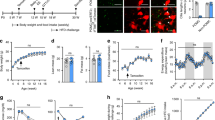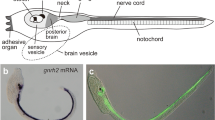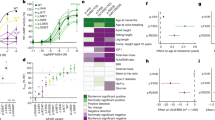Abstract
Ependymal cell cilia help move cerebrospinal fluid through the cerebral ventricles, but the regulation of their beat frequency remains unclear. Using in vitro, high-speed video microscopy and in vivo magnetic resonance imaging in mice, we found that the metabolic peptide melanin-concentrating hormone (MCH) positively controlled cilia beat frequency, specifically in the ventral third ventricle, whereas a lack of MCH receptor provoked a ventricular size increase.
This is a preview of subscription content, access via your institution
Access options
Subscribe to this journal
Receive 12 print issues and online access
$209.00 per year
only $17.42 per issue
Buy this article
- Purchase on Springer Link
- Instant access to full article PDF
Prices may be subject to local taxes which are calculated during checkout



Similar content being viewed by others
References
Veening, J.G. & Barendregt, H.P. Cerebrospinal Fluid Res. 7, 1 (2010).
Tissir, F. et al. Nat. Neurosci. 13, 700–707 (2010).
Mirzadeh, Z., Han, Y.G., Soriano-Navarro, M., Garcia-Verdugo, J.M. & Alvarez-Buylla, A. J. Neurosci. 30, 2600–2610 (2010).
Vígh, B. et al. Histol. Histopathol. 19, 607–628 (2004).
Bittencourt, J.C. et al. J. Comp. Neurol. 319, 218–245 (1992).
Hervieu, G. Expert Opin. Ther. Targets 7, 495–511 (2003).
Nelson, D.J. & Wright, E.M. J. Physiol. (Lond.) 243, 63–78 (1974).
Prochnow, N. & Dermietzel, R. Histochem. Cell Biol. 130, 71–77 (2008).
Chee, M.J., Pissios, P. & Maratos-Flier, E. J. Comp. Neurol. 521, 2208–2234 (2013).
García, M.A. et al. J. Neurochem. 86, 709–724 (2003).
Psarra, A.M. et al. J. Neurocytol. 27, 779–790 (1998).
Guyon, A. et al. J. Neurosci. 29, 2528–2533 (2009).
Marshall, W.F. & Kintner, C. Curr. Opin. Cell Biol. 20, 48–52 (2008).
Davis, R.E. et al. Proc. Natl. Acad. Sci. USA 104, 19422–19427 (2007).
Berbari, N.F., Lewis, J.S., Bishop, G.A., Askwith, C.C. & Mykytyn, K. Proc. Natl. Acad. Sci. USA 105, 4242–4246 (2008).
Stanley, S. et al. Proc. Natl. Acad. Sci. USA 107, 7024–7029 (2010).
Berbari, N.F., Johnson, A.D., Lewis, J.S., Askwith, C.C. & Mykytyn, K. Mol. Biol. Cell 19, 1540–1547 (2008).
Paturle-Lafanechère, L. et al. J. Cell Sci. 107, 1529–1543 (1994).
Prevot, V. J. Neuroendocrinol. 14, 247–255 (2002).
Penet, M.F. et al. Behav. Genet. 36, 732–744 (2006).
Acknowledgements
We thank J.M. Friedman (Rockefeller University) for Pmch-CFP mice, J. Boutin (Institut de Recherche Servier) for the MCHR1 antagonists, F. Kober and T. Troalen for cine phase-contrast MRI tests, A. Le Troter for assistance in three-dimensional reconstruction of brain MRI, C. Houdayer for laser-capture dissections, V. Thieffin for animal care, I. Larre for help with immunoassays, F. Aguila for artwork, J. Chabry and P. Mollard for discussions, G. Agarwal for help with Matlab, and S. Rasika and P. Haghighi for corrections and remarks on the manuscript. Supported by the Agence Nationale de la Recherche (ANR; ANR-08-MNPS-018-01 to J.-L.N., ANR Gliodiabesity project to V.P. and ANR-09-BLAN-0267 to V.P.), the CNRS Institut National des Sciences Biologiques (INSB), European Union 6th Framework Program STREPS/NEST-APES 28594 (J.L.N.), Projets Exploratoires Premier Soutien (INSB; A.G. and J.-L.N.), the Fondation de la Recherche Médicale (J.-L.N.), and postdoctoral fellowships from the ANR-08-MNPS-018-01 and CNRS (INSB) and awards from the Société Française de Nutrition 2011 and the Institut Danone 2012 (G.C.). A.A. was supported by the Douglas Foundation, McGill University, Canadian Fund for Innovation, Research Chair (Tier 2), and Institute for Health Research and the Natural Science and Engineering Council of Canada.
Author information
Authors and Affiliations
Contributions
G.C., F.B., A.V., F.L., B.D., V.P., L.L., C.R., P.M., S.H., P.-Y.R., A.P.-P. and A.G. performed the experiments. N.R. and O.M. engineered analytical tools. A.A. and B.L. engineered Mchr1−/− mice. G.C., A.V., V.P., T.L., R.C., P.-Y.R., J.-L.N. and A.G. analyzed the data. G.C., J.-L.N. and A.G. wrote the paper.
Corresponding authors
Ethics declarations
Competing interests
The authors declare no competing financial interests.
Supplementary information
Supplementary Text and Figures
Supplementary Figures 1–8 and Supplementary Table 1 (PDF 1370 kb)
Supplementary Movie 1
Representative video recording of the CBF of ciliated ependymal cells in the third ventricle. (AVI 1727 kb)
Rights and permissions
About this article
Cite this article
Conductier, G., Brau, F., Viola, A. et al. Melanin-concentrating hormone regulates beat frequency of ependymal cilia and ventricular volume. Nat Neurosci 16, 845–847 (2013). https://doi.org/10.1038/nn.3401
Received:
Accepted:
Published:
Issue Date:
DOI: https://doi.org/10.1038/nn.3401
This article is cited by
-
Bioinspired magnetic cilia: from materials to applications
Microsystems & Nanoengineering (2023)
-
Glial cells as integrators of peripheral and central signals in the regulation of energy homeostasis
Nature Metabolism (2022)
-
Regulation of choroid plexus development and its functions
Cellular and Molecular Life Sciences (2022)
-
Multifaceted actions of melanin-concentrating hormone on mammalian energy homeostasis
Nature Reviews Endocrinology (2021)
-
Schizophrenia-related microdeletion causes defective ciliary motility and brain ventricle enlargement via microRNA-dependent mechanisms in mice
Nature Communications (2020)



